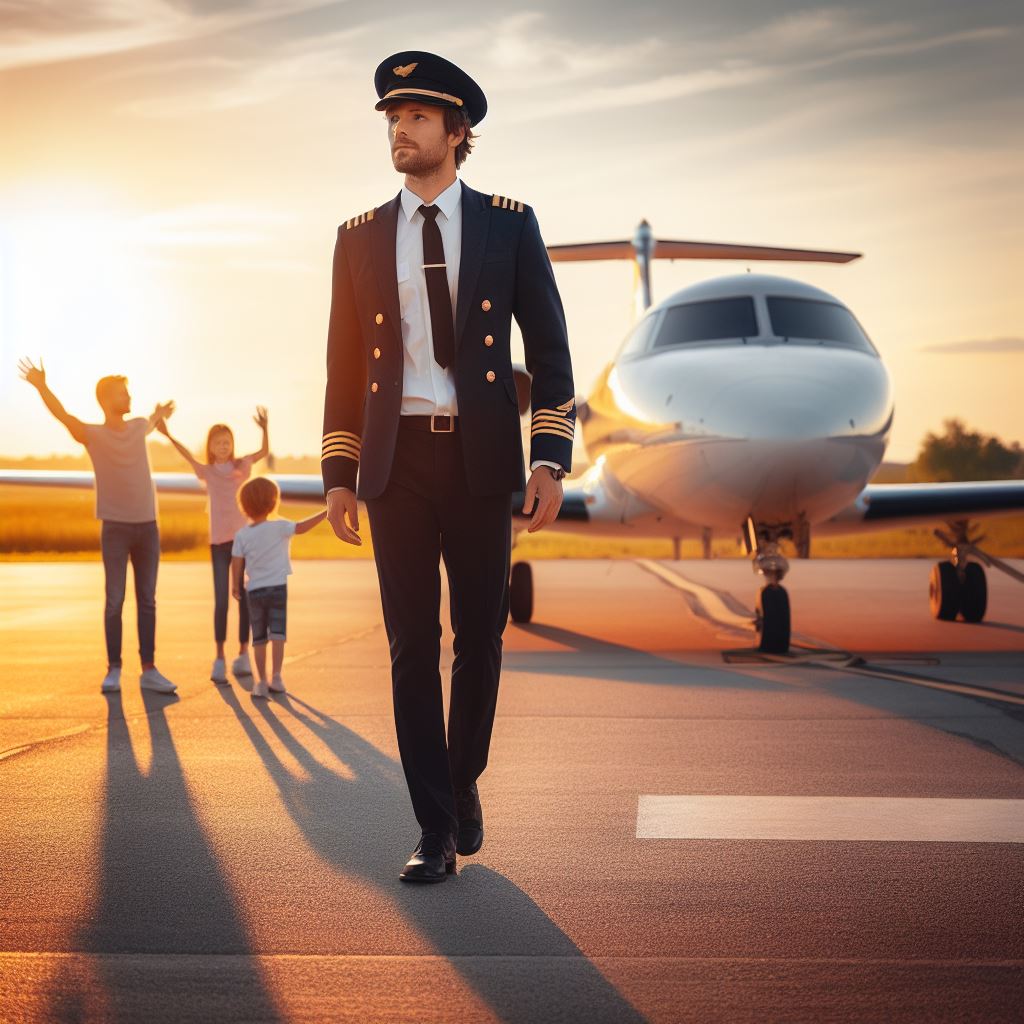Introduction
A. Engaging opening statement about the importance of choosing the right flight school
Choosing the right flight school is crucial for anyone aspiring to become a pilot. It sets the foundation for a successful career in aviation.
B. Brief overview of the aviation industry in the USA
The aviation industry in the USA is thriving, with numerous opportunities and advancements happening every day.
It is a dynamic and fast-paced industry that demands top-notch training from flight schools.
C. Thesis statement
Selecting the right flight school is of paramount importance as it ensures acquiring the necessary skills, knowledge, and experience to excel in the competitive field of aviation.
Factors to Consider When Choosing a Flight School
Choosing the right flight school requires a meticulous evaluation of critical factors.
Let’s delve into these considerations.
A. Cost
Embarking on a journey to become a pilot involves financial planning.
Beyond tuition, flight training encompasses expenses such as aircraft rental, study materials, exams, and more.
To make your dream a reality, it’s essential to understand and budget for these costs.
Diverse payment options exist to ease the financial burden. Investigate loans, scholarships, and installment plans offered by the flight school.
Each option comes with its terms and conditions, so carefully weigh the pros and cons before making a decision.
B. Location
The school’s location is more than just a point on the map. Proximity to your home can significantly impact your overall experience.
Consider travel time, expenses, and the convenience of being close to familiar surroundings.
Moreover, the weather plays a pivotal role in flight training. Different regions experience varying conditions that affect training schedules.
Evaluate how weather patterns in the chosen location may influence your ability to consistently and safely engage in flight training activities.
C. Accreditation
Accreditation adds a layer of assurance to your choice of a flight school.
Look for recognition from trusted aviation organizations like the Federal Aviation Administration (FAA) or the European Union Aviation Safety Agency (EASA).
These bodies uphold rigorous standards, and a school’s accreditation from them reflects its commitment to excellence.
Research the reputations of specific accrediting bodies to ensure they align with your expectations.
A school’s accreditation is not just a formality; it’s a testament to its adherence to industry standards.
Transform Your Career Today
Unlock a personalized career strategy that drives real results. Get tailored advice and a roadmap designed just for you.
Start NowD. Fleet and Facilities
The quality of the training environment significantly influences skill development.
Well-maintained aircraft are crucial for safety and effective learning. Investigate the school’s fleet, ensuring they have modern, reliable aircraft.
Advanced facilities, including classrooms, simulators, and maintenance areas, contribute to a holistic training experience.
A school equipped with cutting-edge resources provides students with the tools they need to excel in their aviation journey.
In general, a thorough examination of these factors ensures you make an informed decision when choosing a flight school.
Consider your goals, preferences, and resources to find the perfect fit for your aviation aspirations.
Read: Union Representation: Benefits for American Truck Drivers
Types of Flight Schools
Choosing the right flight school is a crucial step towards a successful aviation career.
Before enrolling in any flight school, it is essential to understand the different types available, such as Part 61 and Part 141 flight schools, and their respective advantages and disadvantages.
A. Part 61 Flight Schools
Part 61 flight training regulations provide the framework for general aviation pilot training in the United States.
These regulations focus on individualized instruction and offer flexibility in scheduling and lesson content.
1. Brief Explanation of Part 61 Flight Training Regulations
Under Part 61, flight instructors can tailor the training program to meet each student’s needs.
The curriculum covers a wide range of topics, allowing the instructor to adapt the content according to the student’s progress.
2. Advantages and Disadvantages of Part 61 Flight Schools
Advantages
- Lower costs: Part 61 flight schools often have lower hourly rates for aircraft rental and instruction, making it more affordable for aspiring pilots.
- Flexibility: Students can learn at their own pace and schedule flight lessons according to their availability.
- Individualized Instruction: Flight instructors can personalize the training based on the student’s learning style and abilities.
Disadvantages
- Longer training time: Due to the flexibility of Part 61, students may take longer to complete their training compared to a structured program.
- Less structured curriculum: Part 61 flight schools do not have a set syllabus, which may lead to inconsistent training quality or missing essential topics.
B. Part 141 Flight Schools
Part 141 flight training regulations are more stringent and require a structured curriculum approved by the Federal Aviation Administration (FAA).
These schools often cater to students pursuing a professional career in aviation.
1. Brief Explanation of Part 141 Flight Training Regulations
Part 141 flight schools follow a predefined syllabus and training program approved by the FAA.
The curriculum includes minimum flight hours required for each training stage, ground school requirements, and instructor qualifications.
2. Advantages and Disadvantages of Part 141 Flight Schools
Advantages
- Structured training program: The FAA-approved syllabus ensures that all important topics are covered in a systematic manner.
- Faster completion time: Part 141 schools offer a more efficient training process, allowing students to complete their training in less time.
- Eligibility for reduced flight experience requirements: Some airlines or employers may require fewer flight hours from applicants who have trained at a Part 141 flight school.
Disadvantages
- Higher cost: Part 141 flight schools often have higher hourly rates for aircraft rental and instruction due to the structured curriculum and higher operating standards.
- Less flexibility in training schedule: The syllabus and training program in Part 141 schools are more rigid, leaving less room for students to customize their training schedule.
Therefore, both Part 61 and Part 141 flight schools offer unique advantages and disadvantages.
It is crucial to consider your individual learning style, career goals, budget, and available time when choosing the right flight school for your needs.
Researching and visiting different flight schools, speaking with instructors and current students, and reviewing their training programs will help you make an informed decision.
Transform Your Career Today
Unlock a personalized career strategy that drives real results. Get tailored advice and a roadmap designed just for you.
Start NowUltimately, selecting the proper flight school will set the foundation for your aviation journey and contribute significantly to your success as a pilot.
Read: US Truck Stops: More Than Just a Rest Place

Explore Further: From Rookie to Expert: Career Progression for U.S. Logisticians
Researching and Evaluating Flight Schools
When choosing the right flight school, it is crucial to conduct thorough research and evaluation.
This secrion will discuss the various steps involved in researching and evaluating flight schools to help aspiring pilots make an informed decision.
A. Online Resources
- It is essential to utilize reliable websites that provide comprehensive information on different flight schools across the USA.
These websites often offer detailed insights into the training programs, curriculum, costs, and success rates of each school. - Reading reviews and testimonials from current and former students can be incredibly beneficial.
These accounts can provide invaluable firsthand experiences and perspectives on the quality of education, flight instructors, safety standards, and overall satisfaction with the flight schools under consideration.
B. Visiting Flight Schools
- Scheduling visits to potential flight schools is a crucial step in the evaluation process.
It allows prospective students to have a firsthand experience and get a sense of the school’s environment, culture, and facilities. - During these visits, it is important to assess various key factors. Firstly, evaluating the quality of facilities is imperative.
The school should have well-maintained aircraft, modern simulators, and comfortable classroom spaces to provide a conducive learning environment.
Furthermore, interacting with flight instructors and observing their expertise is essential.
The instructors should be knowledgeable, experienced, and have a passion for teaching, as they play a significant role in shaping students’ aviation careers.
Additionally, prospective students should examine the fleet of aircraft available at the flight school.
It is crucial to verify whether the school possesses a diverse range of aircraft types to ensure exposure to various flying experiences and prepare students for different aviation opportunities.
Lastly, understanding the school’s safety protocols and standards is paramount.
Safety should be a top priority for any flight school, and it is crucial to ask about the school’s safety record, maintenance procedures, and adherence to regulatory guidelines to ensure a secure learning environment.
Essentially, researching and evaluating flight schools requires careful consideration of online resources and scheduling visits.
Reliable websites and reading reviews help gather essential information, while visiting potential flight schools allows firsthand assessment of facilities, instructors, and aircraft.
By following these steps, aspiring pilots can make a well-informed decision and choose the right flight school that aligns with their goals and expectations.
Read: The Future of Self-Driving Trucks in the US
Tips for Making the Right Decision
Choosing the right flight school is a pivotal step in your aviation journey.
To ensure a successful and fulfilling training experience, consider the following tips:
A. Seek Recommendations
- Consult Experienced Pilots: Tap into the wealth of knowledge from seasoned pilots or aviation professionals. Their insights can guide you towards reputable flight schools.
- Explore Online Communities: Engage with aviation forums and online communities. Real-world experiences shared by fellow aspiring pilots can provide valuable perspectives.
B. Assessing Curriculum and Training Programs
- Evaluate Curriculum: Scrutinize the flight school’s curriculum. A well-structured program ensures a systematic learning approach, covering essential aviation knowledge and skills.
- Comprehensive Training: Opt for a school offering comprehensive training programs. Look for a balance between ground instruction, simulator sessions, and actual flight time to enhance your skills holistically.
C. Instructor Qualifications and Experience
- Prioritize Qualified Instructors: Instructor qualifications are paramount. Ensure they hold valid certifications and have a proven track record. A knowledgeable instructor lays the foundation for your success.
- Communication and Teaching Style: Assess how instructors communicate and their teaching styles. A harmonious instructor-student relationship fosters effective learning. Choose a school where you resonate with the teaching approach.
Making the right decision involves a blend of research, recommendations, and personal preferences.
By seeking advice from experienced individuals, evaluating training programs, and prioritizing qualified instructors, you pave the way for a successful flight training experience.
Remember, your choice of a flight school shapes your future in aviation; choose wisely.
Transform Your Career Today
Unlock a personalized career strategy that drives real results. Get tailored advice and a roadmap designed just for you.
Start NowRead: Facing Challenges: Mental Health in the Trucking Industry
Conclusion
To recap, we have discussed the importance of choosing the right flight school in the USA.
Selecting the right flight school in the USA is pivotal for aspiring pilots as it significantly influences their aviation career.
A reputable school ensures comprehensive, quality training, which is crucial for safety and competence in the highly regulated aviation industry.
Accredited institutions often have better access to resources, experienced instructors, and state-of-the-art equipment, enhancing the learning experience.
The choice of school also impacts job prospects, as some airlines prefer graduates from recognized programs.
Additionally, considering factors like cost, location, and the type of training offered helps individuals tailor their education to align with their specific career aspirations.
It is crucial to select a suitable flight school to ensure a successful career in aviation.
Selecting the right flight school is crucial for aspiring pilots.
Thorough research ensures a well-informed decision. Consider factors such as accreditation, instructor qualifications, aircraft fleet, safety records, and alumni reviews.
Investigate the school’s curriculum, training facilities, and job placement assistance. Comparing costs and financial aid options is essential.
Visiting the school and speaking with current students can provide valuable insights.
A comprehensive evaluation helps aspiring aviators make confident choices, setting the foundation for a successful and fulfilling aviation career.
We encourage readers to thoroughly research and evaluate flight schools before making a decision.




